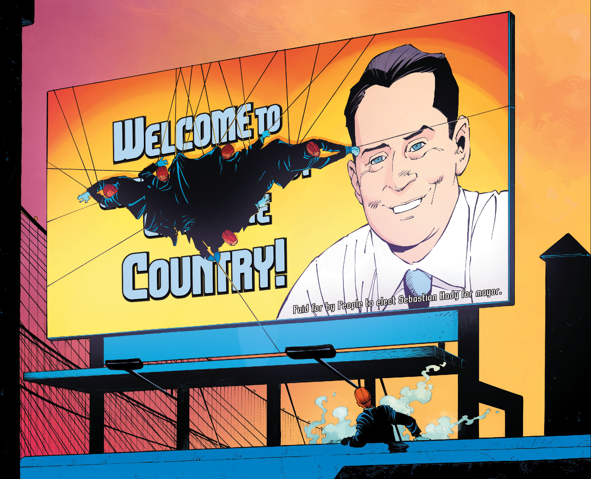Writers: Scott Snyder and James Tynion IV
Penciller: Greg Capullo and Rafael Albuquerque (backup)
Inker: Danny Miki
Colorist: FCO Plascencia and Dave McCaig (backup)
Publisher: DC Comics
In Batman #24, Scott Snyder and Greg Capullo set out to answer the question, “Who is Batman?” How did Bruce Wayne, angry urban vigilante, become the legendary Dark Knight? Snyder and Capullo answer this question through both words and action, earnest speeches and brutal brawls. Each panel on every page acts as a building block in the larger Batman mythos. Some blocks are the same. There are respectful homages to Batman’s first appearance in Detective Comics #27 and a more recent story near the end of the comic. However, Snyder and Capullo add wrinkles into Batman’s origin told in Batman Year One and elsewhere, which make their story stand out. These insights into the character of Batman (who is often overshadowed by his rogues gallery) make Batman #24 a unique and emotionally compelling story. Snyder also manages to fit in an exciting plot to go along with his brilliant study. The extent of Greg Capullo’s artistic genius is also on display from Batman crashing into a pair of thugs for the first time to Bruce’s conversations with Alfred and his Uncle Phil. He is aided by inker Danny Miki, who embellishes characters’ facial expressions and makes sure every punch and kick can be clearly seen. Colorist FCO Plascencia rounds off the art team with his motifs of red-gold flame which represents the forging of Bruce Wayne into Batman.
Scott Snyder makes sure to show the transition from the Bruce Wayne, who lets his temper get the better of him in Batman #22 to the legendary arbiter of justice, Batman. The change is gradual and organic and builds on the previous events of “Zero Year”. For example, in a speech to the people of Gotham, Bruce mentions his father’s question to him as a child, “Why do you love Gotham?” and answers it definitively this time. The connections between Batman and the city he protects are very strong in this issue. Capullo includes a bat silhouette in many of his aerial shots of Gotham, and Snyder explores this relationship through Bruce’s dialogue about Gotham challenging him to be a hero. Bruce Wayne became a vigilante to avenge his parents death, but he becomes Batman to bring hope to the city that he loves. This hope is more greys and dark reds (thanks to FCO Plascencia) than primary colors, but is hope nonetheless. Snyder drives home this idea in a controversial reworking of the Batman mythos that will be talked about for years to come. He also draws a great contrast between Batman and Bruce Wayne through their speech. Bruce uses flourishes of oratory and is well-spoken and articulate. Batman says little. For example, he cuts off a villain’s long winded monologue with a right hook and “Shut up.” Batman #24 is a poetic character study of one of comics’ most beloved character. Every line of dialogue written by Snyder and uttered by Alfred could be fodder for graduate dissertations about Batman for the next century.
But Batman #24 isn’t just eloquent speeches and aphorisms. It has a plot with some breathtaking twists and huge implications for Batman, Gotham, and the Red Hood Gang. It also features plenty of explosions, fist fights, and expert use of gadgetry drawn with great aplomb by Greg Capullo and (the last ten pages by) Rafael Albuquerque. Albuquerque, in particular, nails the silent and dark aspects of Batman as he clambers across rooftops and inspires the people of Gotham in his own special way. However, in the earlier action scenes, Capullo uses smaller panels to illustrate the details of Batman’s exploits against the Red Hood Gang. He uses bigger panels to illuminate scenes that have thematic importance, like any scene with fire or the Red Hood One’s mirror-like visor. The mix between scenes of detective work and dialogue and action/chase scenes makes for both an entertaining and intellectual reading experience.
The combination of Snyder’s script and dialogue with Capullo’s pencils, Miki’s inks, and Plascencia’s color create the ultimate Batman experience. Like an season cinematographer, Capullo uses varied shots and panel compositions to have a different effect on the story. He zooms into Bruce’s face to show his earnest belief in the people of Gotham before casting a page in all black silhouettes when Alfred cuts the power. His opening page where Bruce gets a haircut in front of a smoking furnace cements the theme of Bruce’s physical and mental transformation into Batman. Capullo has a great grasp on the various incarnations of Batman and homages a variety of Batman designs from his first appearance in the 1939 to a panel that looks like an unused storyboard from Batman: The Animated Series. Inker Danny Miki adds the rough edges to Gotham and its denizens. His masterpiece is a badly beaten up Phil Kane, who is probably Bruce’s last living relative. Miki adds rich details to Capullo’s pencils for both setting and character. And FCO Plascencia is the unsung hero of Snyder and Capullo’s entire run. His color choices evoke a variety of emotions, including fear, anger, and hope. He uses subtle changes in hue to contrast characters like dark orange for Bruce and red (obviously) for Red Hood One.
In conclusion, Batman #24 is definitely one of the best single comic book issues of 2013. It has a perfect balance between art, plot, theme, and characterization. Some might say that the book is a little too wordy, but this issue has a lot of ground to cover. It balances the birth of Batman with Gotham’s crime problems while allowing Batman to show his mettle as the World’s Greatest Detective. Batman #24 is a technically perfect comic book with a strong theme and is one of the best chapters of a soon to be legendary run on Batman.


